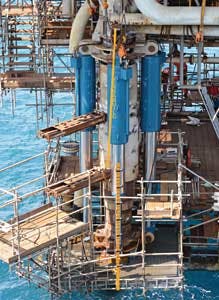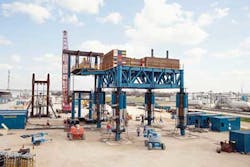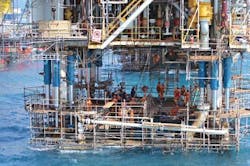Indonesia flow station lifted in simultaneous jacking operation
Lakis Zenios
Versabar Inc.
Nasrullah
Pertamina Hulu Energi Offshore North West Java
Over the life of a production facility, reservoir pressure will reduce as oil and gas flow to the surface. This reduction in reservoir pressure may result in local compaction and consolidation of reservoir rock. Depending upon the local geology, such reservoir compaction may also lead to subsidence. For a fixed offshore platform, one consequence of seabed subsidence is the reduction of the air gap between the average sea level and the underside of the topside, which increases the potential for inundation of the deck in extreme storm conditions. This puts the platform at risk for structural failure under storm loading conditions. As the probability of extreme waves entering the deck increases with further subsidence, some form of remediation will generally be required to ensure that the offshore platform continues to maintain satisfactory levels of structural reliability.
The LIMA flow station off the coast ofJakarta, Indonesia, was built in 1973 by Atlantic Richfield Indonesia Inc. It consists of a production platform, a compression platform, a living quarters platform, three bridges, and flare support structures. The installation was one of 11 flow stations acquired by Pertamina in 2009 with the purchase of BP subsidiary BP West Java and its operated interest in the Offshore North West Java concession.
Although the LIMA flow station had operated normally without remediation, subsidence had significantly reduced the facility's air gap over the years. Operator PT. Pertamina Hulu Energi Offshore North West Java (PHE ONWJ) was concerned that platform safety could be compromised before the planned end of the station's production life in 2026. PHE ONWJ thoroughly evaluated various options to remediate the risk of subsidence, including conventional lifting, on/off operation, construction of new platforms, the use of a mobile offshore production unit, a float-over barge for deck-raising, and deck-raising by hydraulic jacking system. Additional criteria such as technical feasibility, commercial matters, period of shutdown needed, project schedule, and risks were considered during the evaluation. PHE ONWJ concluded that deck-raising by hydraulic jacking offered the best cost-effective and technically sound solution to restore a safe distance between each platform's cellar deck and the mean sea level.
The bridge-linked platform complex needed to be raised 4 m (13 ft) to increase the air gap on three platforms and their supporting structures.Versabar's patented Deck Raising System was selected to raise the entire LIMA flow station simultaneously. The LIMA Subsidence Remediation Project would be the first such operation to use a synchronized hydraulic jacking system with programmable logic controller (PLC) combined with encapsulated leg-sleeves.
PHE ONWJ awarded two contracts: one to PT. SAS International, to provide all specialty deck-raising equipment and services, and one to PT. Timas Suplindo (Timas), for engineering, procurement, construction, and installation. Versabar was subcontracted by PT. SAS International to furnish all synchronized hydraulic jacking equipment.
The company's deck-raising technology was developed in 2006, when aGulf of Mexico operator needed to raise the topsides on two 8-leg drilling and production platforms. Using hydraulically and electronically synchronized rams, each platform was successfully elevated 14 ft (4.27 m) in less than two hours. The technology uses split sleeves to encapsulate the legs throughout the raising process. This encapsulation provides a high degree of lateral stability during the raising operation and subsequently forms the permanent leg extensions.
The custom engineered HPUs (hydraulic power units) that operate the rams incorporate a redundant design using two of everything where applicable, starting with the use of twin 200-hp diesel engine and hydraulic pump arrangements, each with its own fuel supply and cooling capability. In the unlikely event of an engine or pump failure during the raising operation, the units were designed to be able to continue the raising process unaffected. The HPUs also integrate a failsafe design into the control scheme so that in the event of a lost control or hydraulic signal, all operations would automatically halt until the matter was resolved.
Testing and deployment
For the LIMA flow station project, Versabar provided detailed engineering, fabrication, and testing of all deck raising equipment, leg extension sleeves, and other raising appurtenances. Two types of rams were custom engineered to raise the platforms in two stages, and a third type of ram was used to simultaneously raise the supporting bridge structures.
Prior to mobilization, Versabar built a full-scale, detailed deck and bridge construction mirroring one of the platforms in order to perform an accurate system integration test (SIT) at the company's Houston facility. Each stage of the lift was performed, with split sleeves installed on the legs and leg pins inserted at each point of the raising operation, as they would be offshore. The mock-up topside and connecting bridge were raised the full 4 m.
"During the testing of the complete deck raising system, we went above full working load to demonstrate the capacity of the system," says Versabar Project Engineer Sid Fabre. "We also went through a sequence of simulated malfunctions and failure mode testing under load to evaluate the failsafe design and redundancy of the hydraulic and control system."
All equipment was shipped from Houston to Indonesia using project cargo transportation. This included six 400 HP hydraulic power units weighing 20 tons each, one control cabin, and 48 40-ft. shipping containers with a total of 120 rams: 12 rams for the connecting bridges, 48 Stage 1 rams, 48 Stage 2 rams, plus spares. Extra care and preparation was taken to ensure all cargo and components arrived safely and on schedule.
Offshore lift
Timas prepared the platforms for the deck raise by installing all of the Versabar-provided equipment on the topsides and bridges, cutting and capping the risers and appurtenances, installing the sleeves and bushings on the deck legs, and installing the initial raising hydraulic rams. Versabar personnel arrived onsite on Aug. 2, 2013, to perform offshore installation, hook-up, and commissioning of the deck raising system, and operation of the raising equipment for the actual lift.
The procedure was to be conducted in two phases. In Stage I, the rams would raise the platforms 38.5 in. (98 cm) and the leg pins would be inserted. In Stage II, dual-rod rams would raise the platforms to 106 in. (269 cm). After pinning off, the Stage II rams would continue to raise the platforms to 159.5 in. (405 cm), followed by a final leg pinning.
The raising operation began on Sept. 4. All six structures, with a combined weight of approximately 3,300 tons, were simultaneously raised 38.5 in. to complete Stage I of the lift in 2.25 hours. Fifteen days later, after the Stage I rams were removed and Stage II leg extension sleeves and rams were installed, the second phase of the lift took place. Once the structures were lifted to 106 in., the Stage II intermediate pin was inserted, and then raising continued to the full height of 159.5 in. The legs were then pinned again, providing a full mechanical lock-off of the deck in the raised position. Stage II was performed in four hours, which helped play a part in reaching the LIMA Subsidence Remediation Project goal of not only raising the decks, but getting the facility back in production on schedule.
"During the design and testing phases of the project we left no stone unturned," says Fabre. "When installing and commissioning a system for an operation this critical, preparation provides the best opportunity for a safe, problem-free operation."
"This raising of three platforms, three bridges, and flare support structures at once with a synchronized jacking system is a first for PHE ONWJ, Pertamina, Indonesia, and probably the world," says Jonly Sinulingga, executive vice president and general manager for PHE ONW. "The success of this project has given us the experience and confidence to apply the most advanced technology in our offshore operations."
The increased air gap provided by the deck raise is expected to grant the LIMA flow station an additional 12-15 years of use.




